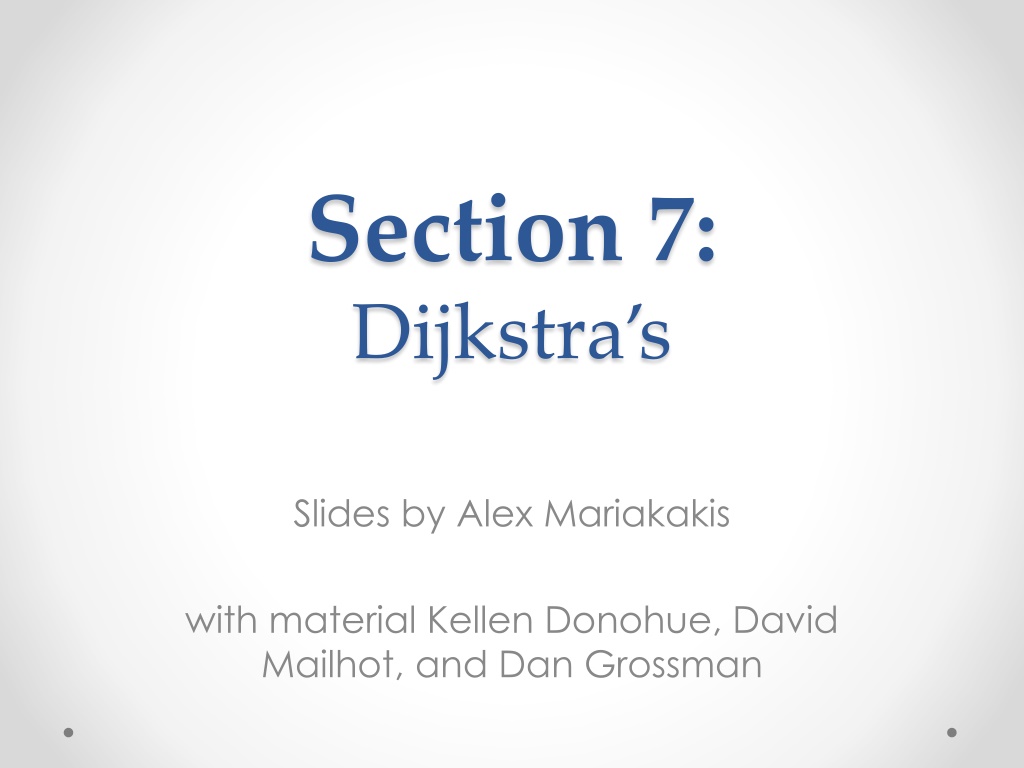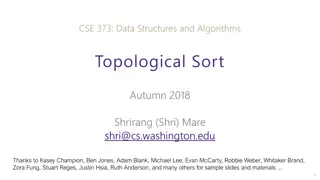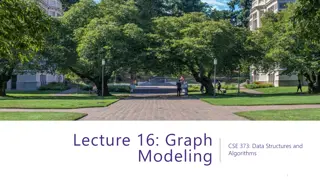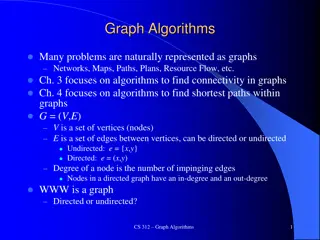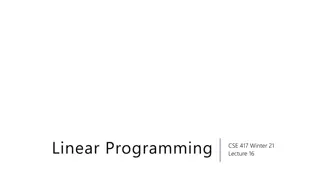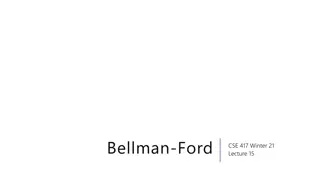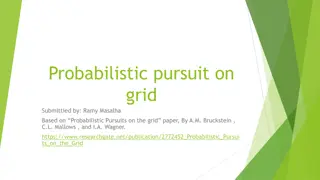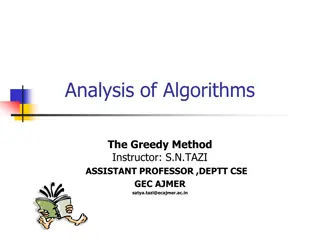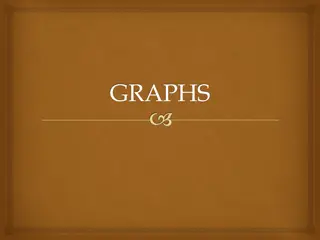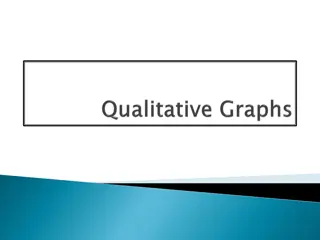Understanding Dijkstra's Algorithm for Shortest Paths with Weighted Graphs
Dijkstra's Algorithm, named after inventor Edsger Dijkstra, is a fundamental concept in computer science for finding the shortest path in weighted graphs. By growing a set of nodes with computed shortest distances and efficiently using a priority queue, the algorithm adapts BFS to handle edge weights. It outperforms BFS when dealing with non-negative weights, providing a reliable method for pathfinding in various applications.
Download Presentation

Please find below an Image/Link to download the presentation.
The content on the website is provided AS IS for your information and personal use only. It may not be sold, licensed, or shared on other websites without obtaining consent from the author. Download presentation by click this link. If you encounter any issues during the download, it is possible that the publisher has removed the file from their server.
E N D
Presentation Transcript
Section 7: Dijkstra s Slides by Alex Mariakakis with material Kellen Donohue, David Mailhot, and Dan Grossman
Agenda How to weight your edges Dijkstra s algorithm
Homework 7 Modify your graph to use generics o Will have to update HW #5 and HW #6 tests Implement Dijkstra s algorithm o Search algorithm that accounts for edge weights o Note: This should not change your implementation of Graph. Dijkstra s is performed on a Graph, not within a Graph. The more well-connected two characters are, the lower the weight and the more likely that a path is taken through them o The weight of an edge is equal to the inverse of how many comic books the two characters share o Ex: If Amazing Amoeba and Zany Zebra appeared in 5 comic books together, the weight of their edge would be 1/5 o No duplicate edges
Review: Shortest Paths with BFS 1 B From Node B Destination Path Cost A 1 A <B,A> 1 1 1 B <B> 0 C <B,A,C> 2 1 D <B,D> 1 C D E <B,D,E> 2 1 1 E
Shortest Paths with Weights 2 B From Node B Destination Path Cost A 100 A <B,A> 2 100 3 B <B> 0 C <B,A,C> 5 2 D <B,A,C,D> 7 C D E <B,A,C,E> 7 6 2 Paths are not the same! E
BFS vs. Dijkstras 1 100 100 1 100 100 5 -10 500 BFS doesn t work because path with minimal cost path with fewest edges Dijkstra s works if the weights are non-negative What happens if there is a negative edge? o Minimize cost by repeating the cycle forever
Dijkstras Algorithm Named after its inventor Edsger Dijkstra (1930-2002) o Truly one of the founders of computer science; this is just one of his many contributions The idea: reminiscent of BFS, but adapted to handle weights o Grow the set of nodes whose shortest distance has been computed o Nodes not in the set will have a best distance so far o A priority queue will turn out to be useful for efficiency
Dijkstras Algorithm 1. For each node v, set v.cost = and v.known = false 2. Set source.cost = 0 3. While there are unknown nodes in the graph a) Select the unknown node v with lowest cost b) Mark v as known c) For each edge (v,u) with weight w, c1 = v.cost + w c2 = u.cost if(c1 < c2) u.cost = c1 u.path = v // cost of best path through v to u // cost of best path to u previously known // if the new path through v is better, update
Example #1 0 2 2 3 B A F H 1 2 1 5 10 4 9 3 G C 2 11 1 D vertex A B C D E F G H known? Y cost 0 path E 7 Order Added to Known Set:
Example #1 2 0 2 2 3 B A F H 1 2 1 5 10 4 9 3 G 1 C 2 11 1 D 4 vertex A B C D E F G H known? Y cost 0 2 1 4 path E 7 A A A Order Added to Known Set: A
Example #1 2 0 2 2 3 B A F H 1 2 1 5 10 4 9 3 G 1 C 2 11 1 D 4 vertex A B C D E F G H known? Y cost 0 2 1 4 path E 7 A A A Y Order Added to Known Set: A, C
Example #1 2 0 2 2 3 B A F H 1 2 1 5 10 4 9 3 G 1 C 2 11 1 D 4 vertex A B C D E F G H known? Y cost 0 2 1 4 12 path E 12 7 A A A C Y Order Added to Known Set: A, C
Example #1 2 0 2 2 3 B A F H 1 2 1 5 10 4 9 3 G 1 C 2 11 1 D 4 vertex A B C D E F G H known? Y Y Y cost 0 2 1 4 12 path E 12 7 A A A C Order Added to Known Set: A, C, B
Example #1 2 4 0 2 2 3 B A F H 1 2 1 5 10 4 9 3 G 1 C 2 11 1 D 4 vertex A B C D E F G H known? Y Y Y cost 0 2 1 4 12 4 path E 12 7 A A A C B Order Added to Known Set: A, C, B
Example #1 2 4 0 2 2 3 B A F H 1 2 1 5 10 4 9 3 G 1 C 2 11 1 D 4 vertex A B C D E F G H known? Y Y Y Y cost 0 2 1 4 12 4 path E 12 7 A A A C B Order Added to Known Set: A, C, B, D
Example #1 2 4 0 2 2 3 B A F H 1 2 1 5 10 4 9 3 G 1 C 2 11 1 D 4 vertex A B C D E F G H known? Y Y Y Y cost 0 2 1 4 12 4 path E 12 7 A A A C B Order Added to Known Set: Y A, C, B, D, F
Example #1 2 4 7 0 2 2 3 B A F H 1 2 1 5 10 4 9 3 G 1 C 2 11 1 D 4 vertex A B C D E F G H known? Y Y Y Y cost 0 2 1 4 12 4 7 path E 12 7 A A A C B Order Added to Known Set: Y A, C, B, D, F F
Example #1 2 4 7 0 2 2 3 B A F H 1 2 1 5 10 4 9 3 G 1 C 2 11 1 D 4 vertex A B C D E F G H known? Y Y Y Y cost 0 2 1 4 12 4 7 path E 12 7 A A A C B Order Added to Known Set: Y A, C, B, D, F, H Y F
Example #1 2 4 7 0 2 2 3 B A F H 1 2 1 5 10 4 9 3 8 G 1 C 2 11 1 D 4 vertex A B C D E F G H known? Y Y Y Y cost 0 2 1 4 12 4 8 7 path E 12 7 A A A C B H F Order Added to Known Set: Y A, C, B, D, F, H Y
Example #1 2 4 7 0 2 2 3 B A F H 1 2 1 5 10 4 9 3 8 G 1 C 2 11 1 D 7 4 vertex A B C D E F G H known? Y Y Y Y cost 0 2 1 4 12 4 8 7 path E 12 A A A C B H F Order Added to Known Set: Y Y Y A, C, B, D, F, H, G
Example #1 2 4 7 0 2 2 3 B A F H 1 2 1 5 10 4 9 3 8 G 1 C 2 11 1 D 7 4 vertex A B C D E F G H known? Y Y Y Y cost 0 2 1 4 11 4 8 7 path E 11 A A A G B H F Order Added to Known Set: Y Y Y A, C, B, D, F, H, G
Example #1 2 4 7 0 2 2 3 B A F H 1 2 1 5 10 4 9 3 8 G 1 C 2 11 1 D 4 vertex A B C D E F G H known? Y Y Y Y Y Y Y Y cost 0 2 1 4 11 4 8 7 path E 11 7 A A A G B H F Order Added to Known Set: A, C, B, D, F, H, G, E
Interpreting the Results 2 4 7 vertex A B C D E F G H known? Y Y Y Y Y Y Y Y cost 0 2 1 4 11 4 8 7 path 0 2 2 3 B A F H 1 A A A G B H F 2 1 5 10 4 9 8 G 3 1 C 2 11 D 1 4 E 11 7 2 2 3 B A F H 1 1 4 G 3 C D E
Example #2 0 2 B 1 A 1 5 2 E 1 D 1 3 5 C 6 G vertex A B C D E F G known? Y cost 0 path 2 10 F Order Added to Known Set:
Example #2 3 0 2 B 1 A 2 1 5 2 E 1 1 D 1 3 5 C 2 6 6 G vertex A B C D E F G known? Y Y Y Y Y Y Y cost 0 3 2 1 2 4 6 path 2 10 4 F E A A D C D Order Added to Known Set: A, D, C, E, B, F, G
Pseudocode Attempt #1 dijkstra(Graph G, Node start) { for each node: x.cost=infinity, x.known=false start.cost = 0 while(not all nodes are known) { b = dequeue b.known = true for each edge (b,a) in G { if(!a.known) { if(b.cost + weight((b,a)) < a.cost){ a.cost = b.cost + weight((b,a)) a.path = b } } brackets O(|V|) O(|V|2) O(|E|) O(|V|2)
Can We Do Better? Increase efficiency by considering lowest cost unknown vertex with sorting instead of looking at all vertices PriorityQueue is like a queue, but returns elements by lowest value instead of FIFO
Priority Queue Increase efficiency by considering lowest cost unknown vertex with sorting instead of looking at all vertices PriorityQueue is like a queue, but returns elements by lowest value instead of FIFO Two ways to implement: 1. Comparable a) class Node implements Comparable<Node> b) public int compareTo(other) 2. Comparator a) class NodeComparator extends Comparator<Node> b) new PriorityQueue(new NodeComparator())
Pseudocode Attempt #2 dijkstra(Graph G, Node start) { for each node: x.cost=infinity, x.known=false start.cost = 0 build-heap with all nodes while(heap is not empty) { b = deleteMin() if (b.known) continue; b.known = true for each edge (b,a) in G { if(!a.known) { add(b.cost + weight((b,a)) ) } brackets O(|V|) O(|V|log|V|) O(|E|log|V|) O(|E|log|V|)
Proof of Correctness All the known vertices have the correct shortest path through induction o Initially, shortest path to start node has cost 0 o If it stays true every time we mark a node known , then by induction this holds and eventually everything is known with shortes path Key fact: When we mark a vertex known we won t discover a shorter path later o Remember, we pick the node with the min cost each round o Once a node is marked as known , going through another path will only add weight o Only true when node weights are positive
